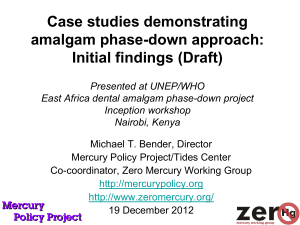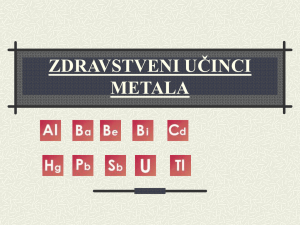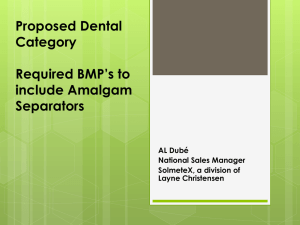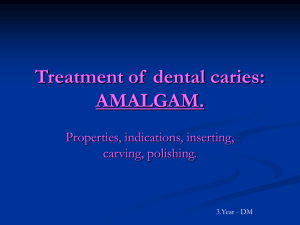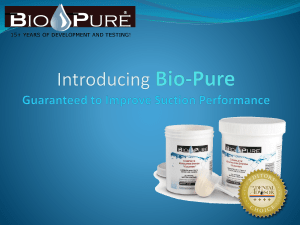- Bay Area Clean Water Agencies
advertisement
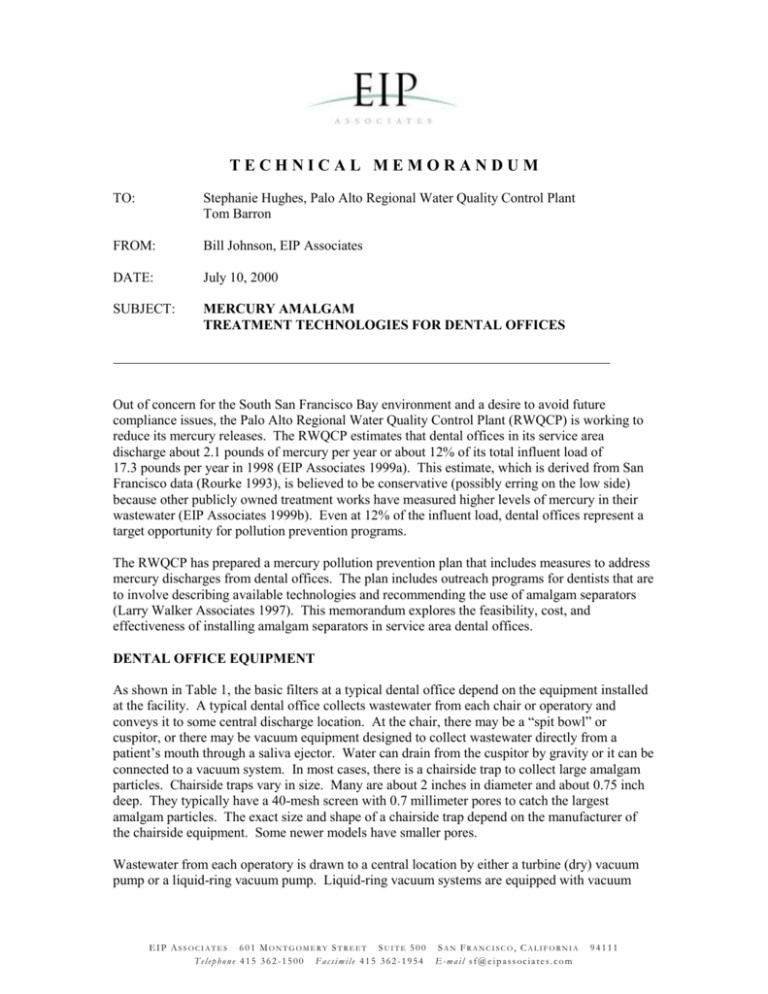
TECHNICAL MEMORANDUM TO: Stephanie Hughes, Palo Alto Regional Water Quality Control Plant Tom Barron FROM: Bill Johnson, EIP Associates DATE: July 10, 2000 SUBJECT: MERCURY AMALGAM TREATMENT TECHNOLOGIES FOR DENTAL OFFICES Out of concern for the South San Francisco Bay environment and a desire to avoid future compliance issues, the Palo Alto Regional Water Quality Control Plant (RWQCP) is working to reduce its mercury releases. The RWQCP estimates that dental offices in its service area discharge about 2.1 pounds of mercury per year or about 12% of its total influent load of 17.3 pounds per year in 1998 (EIP Associates 1999a). This estimate, which is derived from San Francisco data (Rourke 1993), is believed to be conservative (possibly erring on the low side) because other publicly owned treatment works have measured higher levels of mercury in their wastewater (EIP Associates 1999b). Even at 12% of the influent load, dental offices represent a target opportunity for pollution prevention programs. The RWQCP has prepared a mercury pollution prevention plan that includes measures to address mercury discharges from dental offices. The plan includes outreach programs for dentists that are to involve describing available technologies and recommending the use of amalgam separators (Larry Walker Associates 1997). This memorandum explores the feasibility, cost, and effectiveness of installing amalgam separators in service area dental offices. DENTAL OFFICE EQUIPMENT As shown in Table 1, the basic filters at a typical dental office depend on the equipment installed at the facility. A typical dental office collects wastewater from each chair or operatory and conveys it to some central discharge location. At the chair, there may be a “spit bowl” or cuspitor, or there may be vacuum equipment designed to collect wastewater directly from a patient’s mouth through a saliva ejector. Water can drain from the cuspitor by gravity or it can be connected to a vacuum system. In most cases, there is a chairside trap to collect large amalgam particles. Chairside traps vary in size. Many are about 2 inches in diameter and about 0.75 inch deep. They typically have a 40-mesh screen with 0.7 millimeter pores to catch the largest amalgam particles. The exact size and shape of a chairside trap depend on the manufacturer of the chairside equipment. Some newer models have smaller pores. Wastewater from each operatory is drawn to a central location by either a turbine (dry) vacuum pump or a liquid-ring vacuum pump. Liquid-ring vacuum systems are equipped with vacuum EIP ASS OCIATE S 601 MONTGOMERY ST REET SUITE 500 SAN FRANCISC O, CALIFORNIA Telephone 415 362-1500 Facsimile 415 362-1954 E-mail sf@eipassociates.com 94111 TABLE 1 BASIC FILTERS ON TYPICAL DENTAL OFFICE EQUIPMENT Equipment Flow Design Filter Mechanisms Cuspitor Gravity Chairside Trap only Cuspitor Liquid-Ring Vacuum Chairside Trap & Vacuum Filter Cuspitor Dry Vacuum Chairside Trap & Air/Water Separator Saliva Ejector Liquid-Ring Vacuum Chairside Trap & Vacuum Filter Saliva Ejector Dry Vacuum Chairside Trap & Air/Water Separator filters; dry vacuum systems may or may not have equivalent filters. Vacuum filters are intended to protect the vacuum from particles in the waste stream, and in the process, they also collect mercury-containing amalgam particles. Typically, these filters are cylindrical metal cartridges within a plastic housing that screws into a fitting on the vacuum line upstream of the vacuum pump. The cylindrical screen varies in size from 1.5 to 2.5 inches in diameter and 3.5 to 4.5 inches in height. Pore sizes vary considerably. Some screens are coarse, like window screens, while others have pore sizes as small as 0.22 millimeters. The size depends on the manufacturer. Dental offices that have dry vacuum systems instead of liquid-ring systems are equipped with air/water separators. Some solids may settle out in these separators prior to wastewater discharge. AMALGAM PARTICLE SIZE AND FATE Each dentist who works with amalgam generates about 2 grams of mercury amalgam waste per day (Drummond 1995).1 Estimates range from 1.7 to 2.6 grams per day per dentist (Water Environment Federation 1999). A large fraction of this, about 1.2 grams per day, is captured by chairside traps, if available. As shown in Table 2, individual dentists discharge as much as 0.778 grams per day to the sewer if they use only chairside traps. The amount of mercury captured by typical vacuum filters varies. As shown in Table 3, the amount passing through chairside traps and vacuum filters is about 0.37 grams per day per dentist or 0.25 grams per day per chair (each dentist typically uses more than one chair).2 On the basis of San Francisco data, the RWQCP has assumed that dentists discharge far less mercury. This conservatively low estimate is about 0.35 grams per day (Rourke 1993). 1 This discussion is based on over 50 samples collected from the Great Lakes Navel Dental Center and several private dental offices. It does not include mercury not directly associated with wastewater discharges from ongoing activities. For example, it does not address mercury and amalgam particles from past activities, such as any mercury or amalgam particles trapped in existing plumbing (e.g., in the traps below sinks where instruments are cleaned). 2 Air/water separators capture about 0.53 grams per day per dentist, allowing about 0.25 grams per day of mercury to pass into the sewer (Water Environment Federation 1999). 2 TABLE 2 AMALGAM PARTICLE DISTRIBUTION Mercury Load (g/day/dentist) Retained by Chairside Trap 1.177 Passing Chairside Trap and Settling within 24 Hours 0.773 Supernatant Above Settled Particles 0.0051 Soluble Mercury Following Centrifugation of Supernatant 0.0033 Total Generated 1.96 Total Passing Chairside Trap 0.778 Source: Drummond 1995. TABLE 3 BASIC FILTER EFFECTIVENESS (PER DENTIST AND PER CHAIR) Mercury Load (g/day/dentist) Mercury Load (g/day/chair) Total Mercury Generated 2.0 1.3 Amount Retained by Chairside Trap 1.2 0.82 Amount Passing Chairside Trap 0.78 0.51a Amount Passing Secondary Filter 0.37b 0.25 a The load passing chairside traps per chair is presented here as the average of reported values (0.522 and 0.499 grams per day per chair). b The load per dentist passing secondary filters is estimated here on the basis of the ratios between the other loads in the table (per dentist and per chair). Actual measurements vary widely (EIP Associates 1999b). Source: Drummond 1995; Water Environment Federation 1999. As shown in Table 4, about half of the mercury passing through a chairside trap consists of relatively large particles (i.e., particles between 0.21 and 0.7 millimeters. For this reason, filtration and low-technology treatments (such as settling) can effectively capture significant amounts of mercury passing through chairside traps. Most amalgam particles (at least 80%) settle to the bottom of a water solution if left undisturbed for an hour or two. Colloidal particles (fine particles of less than about 0.01 millimeters) tend to remain suspended in solution for long periods and contain 10% or less of the mercury passing through a chairside trap (Cailas 1994). The Municipality of Metropolitan Seattle (King County) tested the mercury removal capacity of two commercially available amalgam separator units and one easily fabricated settling unit designed by King County staff. One commercially available unit operated under the principles of sedimentation and filtration. The other relied on centrifugation. Samples were collected from the 3 TABLE 4 SIZE DISTRIBUTION OF AMALGAM PARTICLES PASSING THROUGH CHAIRSIDE TRAPS Size (millimeters) Fraction 0.21 to 0.7 50% 0.10 to 0.21 40% Less than 0.10a 10% Total Passing Chairside Traps (Less than 0.7) 100% a colloidal particles. Source: Cailas 1994. internal plumbing of office vacuum systems, after chairside traps but before vacuum filters. Both commercially available systems removed about 99.9% of the mercury from the waste stream. The simple hand-made settling device (constructed for about $100) removed 96% (Water Environment Federation 1999). King County concluded that reductions of at least 90% were achievable through available technology (Municipality of Metropolitan Seattle 1991). AMALGAM SEPARATOR VENDORS As summarized in Table 5, various vendors offer amalgam separation products to reduce dental office discharges.3 Avprox, Capital Dental, Dental Recycling North America (DRNA), MDS Matrx, Metasys, Reber Ecological Systems (Rebec), and SolmeteX have provided information regarding the equipment they sell. As summarized in Table 6, these vendors indicate that mercury removal efficiencies of at least 95% are achievable using existing technologies.4 An ISO standard (#11-143) is being developed to ensure that amalgam removal efficiencies are measured in a meaningful and reproducible manner. Table 7 summarizes the information obtained from each of the vendors. The information presented below and in Tables 6 and 7 about equipment and services was provided by the vendors and has not been independently verified. Avprox Available Equipment. Avprox’s Asdex system is a filter located at each chair or at some central location. It occupies less than 1 cubic foot of space and makes no noise. Effectiveness. Avprox claims its mercury removal efficiency is typically at least 95%, and the system can be configured for higher efficiencies. 3 The following vendors could not be confirmed to sell amalgam separation equipment: Amalgo and Siemens Pelton Crane. The following vendors do not sell amalgam separation equipment: Air Techniques and Safety Kleen. The following vendors provided limited information, but their products are not ready to be sold: Mother Nature Clean (Health 2000) and Wesdent International. 4 A Stockholm study found that maintenance (emptying and cleaning) is the determining factor in how well separators work (Water Environment Federation 1999). 4 TABLE 5 AMALGAM SEPARATION TECHNOLOGY VENDORS Vendor Location Contact Information Contact Person Avprox Inc. 2201 4th St. North, Suite C St. Petersburg, FL 33704 Phone: (727) 823-6609 Fax: (727) 827-0984 E-mail: mutt3905@aol.com Robert Hearn Capital Dental MN Phone: (651) 222-1201 Michael Schafhauser DRNA (Dental Recycling North America) P.O. Box 1069 Hackensack, NJ 07601 Phone: (800) 360-1001 Fax: (201) 489-4470 E-mail: rmdonnelly@aol.com Robert Donnelly MDS Matrx 145 Mid County Dr. Orchard Park, NY 14127 Phone: (716) 662-6650 x 228 Fax: (716) 662-7130 Mike Swart Metasys 1521 Alton Rd., PMB 413 Miami Beach, FL 33139 Phone: (305) 576-5955 Fax: (305) 576-5259 Angelika Tompas Rebec (Reber Ecological Systems) 18921 Dellwood Dr. Edmonds, WA 98026 Phone: (800) 569-1088 Fax: (800) 964-1412 E-mail: rebecsys@cmc.net Tim Reber R&D Services Seattle, WA Phone: (206) 525-4994 Fax: (206) 525-2063 Ross Fraker SolmeteX 29 Cook St. Billerica, MA 01821 Phone: (978) 262-9890 Fax: (978) 262-9889 E-mail: jcannon@solmetex.com Jim Cannon Installation / Maintenance. Installation involves two plumbing connections. Canisters must be replaced monthly, or when the vacuum pressure begins to fall, as when the canister fills. Customers are responsible for disposing of used canisters. The amalgam waste is encapsulated within the canisters; therefore, in some parts of the country, used canisters can be disposed of as solid waste. Avprox anticipates that, as its business grows, dentists will be able to return used canisters to Avprox paying only for shipping. There will be no cost for disposal because recyclers will recover some economic value from the waste. Costs. The purchase price for the equipment is $215, which includes four canisters. Installation costs are minimal because there are only two plumbing connections and no electrical connections. Dental supply companies may provide this service for a fee. Replacement canisters cost about $35 each. Other Issues. Most units are installed in the eastern U.S., although the number of units installed is unknown. Apparently, none are near San Francisco. 5 TABLE 6 PRINCIPLES OF SEPARATION, BY VENDOR Avprox Sedimentation Filtration X X 95% X 98-99%a 95-99% non detectb Capital Dental DRNA System #1 System #2 X X X X MDS Matrx X X Metasys X Rebec System #1 System #2 X X R&D Services X SolmeteX Ion Exchange Adsorption X % Removal 96% X 95-98% X X X X X 95% non detectc 90-95% Xd X 99.99% a This value may be inflated because it is based on the total amount of amalgam entering the chairside trap, whereas the other values in the table are based on the amalgam leaving the trap. b No mercury is detected using EPA Method 1631. c No mercury is detected using standard methods. d The separation relies on chemical-specific chelation, not traditional adsorption (e.g., carbon adsorption). Capital Dental Available Equipment. A dentist has invented a membrane filter that fits within chairside traps. The pore size of the filter is about 0.005 millimeters. Because the filter fits inside the existing trap, it requires no additional space. It also makes no noise. No significant loss of vacuum pressure has been reported. A firm is being sought to distribute the product. Effectiveness. According to Capital Dental, the membrane captures up to 98 to 99% of the solids that enter the trap. Unlike the removal efficiencies reported by other vendors, this value is based on the total amount of amalgam entering the chairside trap, not the amount of amalgam leaving the trap. The fraction of mercury typically captured by a chairside trap (not considered in most removal efficiency calculations) is substantial. Therefore, the 98-99% removal efficiency may appear to inflate the performance of the Capital Dental product if compared directly to the efficiencies of the other products. Installation / Maintenance. Because the membrane filter captures more mercury than the basic chairside trap, the trap must be cleaned more frequently. The filter is intended for use with disposable traps. The filter keeps the trap cleaner, so changing it is less unpleasant. Customers are responsible for arranging for their own waste disposal. 6 TABLE 7 SUMMARY OF VENDOR INFORMATION Products Installation & Maintenance Cost Other Information Avprox Filter located at each chair or at centralized location. Less than 1 cubic foot. No noise. Installation involves two plumbing connections. Canisters must be replaced monthly, or when the vacuum pressure begins to fall. Customers are responsible for disposing of used canisters. Purchase price is $215, which includes four canisters. Replacement canisters cost about $35 each. Most units are installed in the eastern U.S., although the number of units installed is unknown. Apparently, none are near San Francisco. Capital Dental Membrane filter fits within chairside trap. Pore size is about 0.005 millimeters. Requires no additional space. No noise. No significant loss of vacuum pressure. Chairside traps must be cleaned more frequently (e.g., every 5 days or so). Intended to be used with disposable traps. Keeps trap cleaner, so changing it is less unpleasant. Customers are responsible for waste disposal. Not on the market yet. Price expected to be about $0.15 each (in addition to the $0.33 to replace a disposable trap.) About 10 Minnesota dentists currently use filter. DRNA Particle traps located at the dental chair, replacing traditional chairside traps. Amalgam separators, fine particle filters, and adsorbent columns placed in a central location. Particle traps are 9inch long cylinders with 2-inch diameters. About 10.5 x 6 x 6 inches, or 0.2 cubic feet. Fine particulate filters and adsorbent columns each about 10 inches long with 3-inch diameters. No noise. Installation is the responsibility of the dentist. No routine maintenance other than recycling trapped amalgam. Particle traps must be replaced every 3 to 6 months. Amalgam separators must be recycled annually. Replacement periods for the fine particulate filters and adsorbent columns depend on the discharge requirements to be achieved. DRNA arranges for mercury amalgam recycling. Chairside particle traps sell for $125 each. Amalgam recycling costs $10/month for each trap. DRNA leases amalgam separators for $100/month, which includes amalgam recycling. Costs for the fine particulate filters and adsorbent columns add $50/month to the leasing cost. DRNA has installed 16,000 units in Northern Europe and North America. Some are located in Northern California. MDS Matrx Device can be placed chairside, but usually at a central location. About 10 x 15 x 10 inches (0.8 cubic feet). No noise. Dealers install. Canister must be replaced every 6-12 months. Full canisters are returned to MDS Matrx via UPS for recycling. Cost is $2,730, not including installation. Full canisters are returned at no charge other than shipping. 18 units, mostly in Western Canada. One unit sent to Sacramento. Continued 7 TABLE 7 (CONTINUED) SUMMARY OF VENDOR INFORMATION Products Installation & Maintenance Cost Other Information Metasys Device can be connected chairside or at central location. About 13 x 8 x 8 inches (0.5 cubic feet). No noise. Installed in the main vacuum line, directly before the vacuum. Needs to be replaced every 1-2 years. Metasys recycles dental amalgam in Austria. Lease at $48 for up to three units and $59 for more than 3 units. Requires a down payment of $400. 30 units in U.S., 10 in the Miami and 20 in Chicago. None in California. Rebec RME2000 and RME2000 Gold placed in a central location, not chairside. About 28 x 8 x 20 inches (2.6 cubic feet). No noise. Dealer installs and maintains. Dealer collects waste sludge and sends to Washington via a courier service. Basic cost between $1,700 and $1,900 for RME2000. Recycling fee is $325 for the dealer, who also adds a mark-up. About 50 units installed. Half in Washington and others are in Maryland, Kentucky, Tennessee, Oregon, Michigan, North Carolina, Canada, and Mexico. Rebec believes California’s hazardous waste transportation and disposal requirements do not accommodate its existing recycling procedures. R&D Services Sedimentation tank installed at central locations (chairside is possible). Cylinders are 6 inches in diameter with lengths of 9, 12, or 18 inches. Little noise. Chairside installation involves cutting the vacuum line and attaching both ends to the unit. R&D Services installs the equipment for local dentists. Vacuum cannot be too strong or the unit can collapse. Customer responsible for waste management, which is necessary roughly every 6 months or so. One unit costs $375 installed or $325 uninstalled. About 20 installed in Washington and 1 in South Carolina. SolmeteX Smaller system for individual dental offices and larger system for clinics and dental schools. About 18 x 18 x 4 inches (0.75 cubic feet) for smaller system. About 34 x 18 x 8 inches (2.8 cubic feet) for larger system. No noise. Installation may require a plumber. Smaller filter cup needs to be replaced each month. Larger cartridge lasts two or three months. Disposal not included. Smaller system costs $150. Replacement cups are $50 each. Larger system costs $1,250. Installation may cost $200. 6 units installed in Illinois, Texas, Iowa, and Massachusetts. 8 Costs. These filters are not on the market yet, so a price has not been determined. The price has been estimated at about $0.15 each. This must be added to the cost of replacing the disposable chairside traps. The disposable chairside traps need to be replaced more frequently when used in conjunction with this product. Disposable chairside traps are said to cost about $0.33. Other Issues. About 10 dentists are currently using the membrane filter free of charge. They are all located in Minnesota. Feedback has been positive. Dental Recycling North America (DRNA) Available Equipment. DRNA offers particle traps, amalgam separators, fine particle filters, and adsorbent columns. The particle traps are located at the dental chair and the other units are placed in a central location after the vacuum filter but before the drain. A ball check valve is available for installation before the drain. The particle traps replace the traditional chairside coarse filter traps and, together with the amalgam separators, operate on the principle of sedimentation. The adsorbent columns contain activated carbon. The fine particle filters and adsorbent columns are intended for when lower mercury discharges are desired than can be achieved with the more conventional trap and sedimentation steps. The particle traps are 9-inch long cylinders with diameters of about 2 inches. The amalgam separators are about the size of a small car battery (10.5 by 6 by 6 inches, or about 0.2 cubic feet). The fine particulate filters and adsorbent columns are each about 10 inches long filters with diameters of about 3 inches. None of the equipment makes any substantial noise. Effectiveness. DRNA claims mercury removal efficiencies of 95-99% can be achieved using particle traps and amalgam separators. With fine particle filters and adsorbent columns, mercury discharges are not detected when using EPA Method 1631. Installation / Maintenance. Installation is the responsibility of the dentist and requires the purchase of such equipment as wood screws, high pressure hose and tubing, PVC piping and elbows, rubber connectors, clamps, and Teflon tape. No routine maintenance is necessary other than recycling trapped amalgam. The particle traps must be replaced every 3 to 6 months, and the amalgam separators must be recycled annually. Replacement periods for the fine particulate filters and adsorbent columns depend on the discharge requirements to be achieved. DRNA arranges for mercury amalgam recycling. Costs. Chairside particle traps sell for $125 each. Amalgam recycling costs $10/month for each trap. DRNA leases amalgam separators for $100/month, which includes amalgam recycling. Costs for the fine particulate filters and adsorbent columns add $50/month to the leasing cost. Other Issues. DRNA has installed 16,000 units in Northern Europe and North America. Some of these units are located in Northern California. A dentist in Danville received an award from the Central Contra Costa Sanitary District Board for installing a DRNA system in his office. MDS Matrx Available Equipment. This amalgam separator relies on the processes of sedimentation, filtration, and ion exchange. A series of eight chambers includes one to stabilize the flow, two for sedimentation, two for filtration, two for ion exchange, and another to stabilize the flow at the exit. The filtration medium contains activated carbon and specially formulated brick granules. The ion exchange medium is a naturally occurring material high in phenol chemical groups. The material is sulfonated to add additional exchange groups (e.g., OH, SO3H, and SO4H). These 9 groups are selective for most heavy metals. The equipment can be placed chairside, but it is usually more economical to operate at a central location. Its dimensions are 10 by 15 by 10 inches, or about 0.8 cubic feet. It has no moving parts and makes no noise. Effectiveness. According to MDX Matrx, its system is 96% effective as determined by the Berlin Test Method. Efficiency can be improved by connecting additional ion exchange columns in series. Installation / Maintenance. Installation usually requires about 15 minutes (occasionally up to an hour). Dealers install the equipment. The filter canister must be replaced every 6 months to a year. The canister rests on a scale, and an audible and visible indicator alerts the user when the canister is almost full. Full canisters are returned to MDS Matrx via UPS, stored for a while, and then shipped to London for recycling. Costs. The retail cost is $2,730. Installation is not included. Full canisters are returned at no charge other than shipping. Apparently, new canisters are provided free of charge. Other Issues. So far, 18 units have been sold, mostly in Western Canada. One unit was sent to Sacramento in 1996. Because the equipment is sold through dealers, MDS Matrx has no information regarding the end users. While at first there were some installation problems due to issues specific to the customers’ offices, the device has since been designed to correct simplify the installation process. Metasys Available Equipment. Metasys sells three amalgam separation products: a high-tech separator sold in Europe, a simplified version of the high-tech unit, and the ECO II, a separator designed for the U.S. market. The ECO II operates on the principle of sedimentation. It can be connected chairside or at some central location. Its dimensions are about 13 by 8 by 8 inches (about 0.5 cubic feet), and it makes no noise. Effectiveness. Metasys reports that laboratory tests performed in accordance with the draft ISO standard (#11-143) and testing performed by the Great Lakes Mercury Reduction Project (through the Western Lake Superior Sanitary District) have concluded that the removal efficiency of its device is 95 to 98%. Installation / Maintenance. The ECO II is typically installed in the main vacuum line, directly before the vacuum. It needs to be replaced every 1 to 2 years, depending on how many dental units it serves and how many patients are seen. Metasys is in the business of recycling dental amalgam. Located in Austria, it is the largest dental waste recycler in Europe. Costs. Metasys leases its amalgam separation equipment for a down payment of $400. The monthly fee is $48 for up to three units and $59 for more than 3 units. Other Issues. Metasys has installed 30 units in the U.S., 10 in the Miami area and 20 in the Chicago area. No Metasys units are installed in California. Rebec Ecological Systems Available Equipment. Rebec offers the RME2000 system. The RME2000 Gold system is being developed and is not currently on the market. The RME2000 system relies on the principles of 10 sedimentation followed by ion exchange. The ion exchange medium also provides some particle filtration. The RME2000 Gold system adds mercury adsorption through a polystyrene filter. In either case, the equipment is placed in a central location, not chairside. The dimensions of the RME2000 are 28 by 8 by 20 inches, or about 2.6 cubic feet. Neither system makes any noise. Effectiveness. Rebec reports that, according to the King County analysis, the mercury removal efficiency of the RME2000 system is 95%. With the RME2000 Gold system, mercury discharges are not detected when using standard analytical protocols (i.e., better than 99.9% removal). Installation / Maintenance. Installation involves attaching hoses to the system and is included with the purchase price. The only maintenance is annual dealer servicing. Rebec sends a reminder card, and the dealer follows up to collect the waste sludge. Customers send their amalgam sludge to Washington via a courier such as Federal Express for recovery. California hazardous waste transportation laws do not necessarily accommodate this procedure. Costs. The basic system costs between $1,700 and $1,900, depending on dealer mark-up. This cost includes installation. The cost of the RME2000 Gold system has not been determined. It is not yet on the market. The recycling fee is $325 for the dealer, who also adds a mark-up. Other Issues. Rebec has installed about 50 units. Half of them are in Washington, and others are in Maryland, Kentucky, Tennessee, Oregon, Michigan, North Carolina, Canada, and Mexico. None are in California because Rebec believes California’s hazardous waste transportation and disposal requirements do not accommodate its existing recycling operations.5 R&D Services Available Equipment. R&D Services offers a sedimentation tank that allows amalgam particles to settle out of the wastewater stream. The operating principle is similar to that employed by an air/water separator, but it allows more time for settling to occur. R&D units can be installed chairside, but central locations are typically more convenient and economical. The equipment is cylindrical in shape, typically with a 6-inch diameter. The length of the cylinder can be 9, 12, or 18 inches. The larger units are most common.6 The units make very little noise. Effectiveness. R&D Services has indicated that King County has certified its equipment to remove at least 90% of the mercury in dental office wastewater. The actual removal efficiency is probably up to 95%. Installation / Maintenance. Chairside installation involves cutting the vacuum line and attaching both ends to the unit. R&D Services installs the equipment for local dentists. The procedure is similar, although often simpler, when connecting a unit in a central location. Care must be taken to ensure that the vacuum is not too strong, or the unit can collapse. The unit takes a long time to fill. One can observe the filling process, because the unit is made of clear plastic (color can be added, if desired). The customer is responsible for waste management, which is necessary about every 6 months. So far, no one’s tank has filled. However, when necessary, R&D Services plans to work with a recycler to allow customers to directly ship full units to the recycler for cleaning 5 Other vendors appear less concerned regarding potential hazardous waste transportation and disposal liability. 6 The Metropolitan Council Environmental Services Wastewater Division in Minneapolis/St. Paul is testing a unit 3 feet long and 7 inches in diameter. 11 and disposal via United Parcel Service or Federal Express. The recycler has agreed to return cleaned units to the customers, thereby reusing the plastic. Costs. One unit costs $375 installed or, if installation is not available, $325 uninstalled. Installation is a matter of connecting hoses. For the time being, customers must negotiate their own waste disposal rates. Other Issues. R&D Services has about 20 installed in Washington and 1 in South Carolina. SolmeteX Available Equipment. SolmeteX offers two systems, a smaller one for individual dental offices and a larger one for clinics and dental schools. Both systems combine traditional filtration with a chemical-specific chelating resin that adsorbs mercury ions. After the wastewater flows through some pre-filters, it may need to be treated to oxidize the remaining mercury. The mercury ions bind to the chemical-specific resin. The smaller system occupies a space of 18 by 18 by 4 inches, or about 0.75 cubic feet. The larger system occupies a space of 34 by 18 by 8 inches, or 2.8 cubic feet. The equipment does not make substantial noise. Effectiveness. SolmeteX claims mercury removal efficiencies of 99.99% for the smaller system. With the larger system, mercury discharges are not detected when using EPA Method 1631. Installation / Maintenance. Installation is the responsibility of the dentist and may require the assistance of a plumber. The filter cup that comes with the smaller system should be replaced each month. The cartridge used with the larger system lasts two or three months, depending on flow and usage. Dentists must arrange for mercury recycling. Costs. The initial cost of the smaller system is $150. Replacement costs are $50 each. The larger system can be purchased for $1,250. Installation may cost up to another $200. Other Issues. SolmeteX has installed 6 units in dental offices in Illinois, Texas, Iowa, and Massachusetts. COSTS AND ALTERNATIVES Options for reducing amalgam discharges exist beyond those described above. For example, one study recommends replacing the chairside trap’s typical 40-mesh screen (pore size 0.7 millimeters) with a smaller pore size 100-mesh screen. These somewhat better traps, however, only catch between 3% to 5% of the amalgam particles, allowing most of the mercury to go through (DelConte 1997). Moreover, this option does not appear to be commercially available at this time. When confronted with the need to reduce mercury discharges, at least one resourceful dentists in Richmond, California, devised his own treatment device by connecting a commercially available drinking water filter just after the vacuum trap. This type of filter is available in hardware stores. It is cylindrical, with a tube entering and a tube exiting. Different pore sizes are available, but the largest pore size available for drinking water is adequate for amalgam particles. The largest pore size is desirable because the pore size needed for drinking water gets clogged easily by amalgam particles (Friday 1999). 12 The cost of the equipment sold by the vendors discussed in this memorandum varies considerably. According to the vendors surveyed, the original equipment purchase ranges from about $200 to about $3,000. Annual maintenance costs range from less than $400 to as much as $2,500, including amalgam disposal costs. In one case, the vendor claims to replace filled canisters at no costs other than shipping. In the case of Capital Dental, the annual cost per chair (if actually available) would be about $25, not including disposal. The Northern Virginia Planning District Commission has studied the costs of amalgam reduction equipment and determined that chairside traps and vacuum pump filters remove the most mercury relative to their annual costs (Northern Virginia Planning District Commission 1999). As the sophistication of the amalgam separation equipment increases, the cost also increases. Similarly, the cost per pound of recovered mercury also increases. The diminishing return for each dollar spent on mercury treatment units suggests cost effectiveness is an important consideration when selecting a treatment technology. In some cases, less expensive alternatives may be worthy of investigation. REFERENCES Cailas, Michael, et al., “Physico-chemical Properties of Dental Wastewater,” WEFTEC ’94 Water Environment Federation 67th Annual Conference & Exposition, October 15-19, 1994. DelConte, Mary Joy, University of Rochester School of Medicine and Dentistry, A Mercury Pollution Prevention Study for Medical and Dental Centers Findings Report, prepared for the Monroe County Mercury Pollution Prevention Task Force, Rochester, New York, May 9, 1997. Drummond, J. L., et al., “Dental Waste Water: Quantification of Constituent Fractions,” Academy of Dental Materials, Abstract P-22, 1995. EIP Associates, “1998 Mercury Sources,” technical memorandum prepared for the Palo Alto Regional Water Quality Control Plant, April 23, 1999a. EIP Associates, “Mercury Source Identification Update: Dental Offices and Human Waste,” technical memorandum prepared for the Palo Alto Regional Water Quality Control Plant, March 2, 1999b. Friday, Steve, City of Richmond, telephone conversation with Bill Johnson, EIP Associates, November 22, 1999. Larry Walker Associates, Mercury Pollution Prevention Plan, prepared for the Palo Alto Regional Water Quality Control Plant, October 1997. Municipality of Metropolitan Seattle, Dental Office Waste Stream Characterization Study, September 1991. Northern Virginia Planning District Commission, Northern Virginia Mercury Reduction Project: Exploring Opportunities to Reduce Mercury Discharges from Dental Offices (draft), August 5, 1999. Rourke, Daniel, “City and County of San Francisco Dental Related Facilities – Heavy Metals Loadings,” The Bulletin, published by the California Water Environment Association, Fall 1993. Water Environment Federation, Controlling Dental Facility Discharges in Wastewater, 1999. 13
